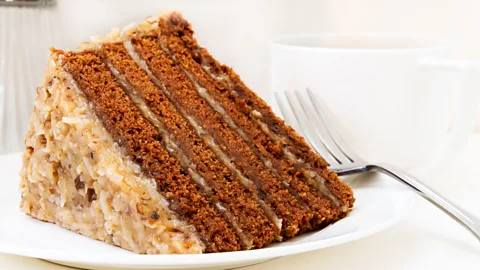What makes a recipe go viral?
 Getty Images
Getty ImagesIndividual recipes have always been able to capture our hearts – but what does it take to stand out when the internet is overflowing with tasty suggestions?
You might not know Alison Roman’s name, but if you’re someone who cares about food and spends time on the internet, you’ve no doubt seen examples of her work.
Roman, a recipe developer and writer who used to be a senior editor at Bon Appetit and Buzzfeed, published her first cookbook, Dining In, in 2017. Of the 125 recipes she featured in her book, one in particular got so much attention, and became so ubiquitous on Instagram, that it earned a viral hashtag of its own: #TheCookies.
On Instagram, #TheCookies has 4,345 posts, most of them home cooks sharing their version of the chocolate chunk shortbread cookie recipe that Roman has in her book. From December 2017 to January 2018, you couldn’t seem to escape posts by food enthusiasts trying and sharing her recipe.
Then, in November 2018, Roman’s column in the New York Times produced another recipe with a cult following, this time a turmeric and coconut milk chickpea stew that quickly became known on Instagram as #TheStew.
Roman, for her part, doesn’t know what underlying factor made the chickpea stew and shortbread cookies so popular; otherwise, she says, she would do it all the time. “Chickpea recipes have been around forever and will be around forever. That one just happened to be successful, I'm not even really sure why,” she says.
 Alison Roman
Alison RomanUsability, cookability
Part of what’s different about Roman’s success is that people actually try out her recipes. Powerhouses in the world of viral food videos like Buzzfeed’s Tasty vertical (and its many offshoots, including Tasty Japan and Tasty Vegetarian) rack up millions of views through “hands and pans” videos – accelerated overhead shots of hands making a dish.
These videos are entertaining and are meant to be shared. But as recipes, they aren’t always that useful. Not all producers do testing to ensure the recipes that they’re promoting will actually work when repeated multiple times in multiple kitchens. They’re also mostly anonymous.
Roman’s recipes, however, are backed by her links to prestigious publications and written for an audience of unknown culinary ability, with unknown equipment. It’s not just a feat of technical writing, it’s an art form which, like many art forms, people who excel at make look easier than it is.
 Alison Roman
Alison RomanOne thing that many recipes that become popular on the internet have in common, like no-knead bread or Instant Pot butter chicken, is that they have an accessibility that invites people to try them out.
“I want it to be easy for everybody,” Roman says. “I don't care where you live or how big your kitchen is or what equipment you have, I want you to be able to execute this recipe.”
“To me, viral recipes are things that only exist on the internet. And actually, this is something that exists in people's homes,” she adds. “While they may never be as popular as a cheese pull video, to me it is so much more significant that they became successful because people are actually cooking them.”
Social success
A big part of the success of very popular recipes in 2019 is, of course, social media. Roman’s savvy as a recipe developer is amplified by her fluency with Instagram, where she has almost 200,000 followers.
 Alison Roman
Alison RomanShe often answers questions about the recipes she’s published and shares her followers’ attempts at her recipes on her stories, helping make #TheStew and #TheCookies as much of a community as a way of making dinner or dessert. It helps attach her name and presence to the recipe, rather than it being sourced anonymously from the internet.
“We're definitely living in an age where food is having a moment, yet I still think most recipe developers remain fairly unknown outside of the food media space,” said Rebecca Firkser, a New York-based recipe developer and food writer.
“So when someone with a larger social following, like Alison Roman, publishes a recipe, people are more likely to see it as they're scrolling online and be compelled to actually make the dish.”
“The publication also contributes to recipe virality. A recipe published on a lesser-known blog or website is much less likely to go viral than those published in the New York Times or Bon Appetitsimply because of the larger audience,” Firkser notes.
And one element is simply keeping up with what’s new. “When an influencer makes a recipe, others want to emulate them for cultural relevance.”
 Getty Images
Getty ImagesIn the know
In that way, Roman’s recipes are just the latest in a long line of recipes that became wildly popular through sharing. It’s just that before the internet came along, the way that recipes were passed on was through newspapers and word of mouth, rather than Twitter and Instagram.
“Recipes were ‘trending’ even long before the internet,” explains Dr Kimberly Voss, associate professor at the University of Central Florida and author of The Food Section: Newspaper Woman and the Culinary Community.
“There’s a certain point in time that it was about showing off, like a lot of the early Julia Child stuff. It was a kind of prestige for a home cook in making something that took a lot of skill or fancy ingredients, that I think still exists,” Voss says.
And, just like in 2019, some of what made a recipe gain in popularity was being part of the club of people making it. “There was also this idea of keeping up with the cool food people, and that kind of pressure – if everyone is making this particular dish, you should too.”
 Alamy
AlamyAnd they were often pushed by food brands, as much as by food editors and recipe developers. Take the German Chocolate Cake, a recipe that has nothing to do with Germany, but rather originated as “German’s Chocolate Cake”, after German’s Sweet Chocolate Baking Bar, a product made by confectioner Baker’s.
The recipe was published in the Dallas Morning Newsin June 1957by George Clay and became so widely requested that Baker’s Chocolate began distributing it to other newspapers, resulting in a spike in sales of baking chocolate.
With the rise of social media, documenting your efforts at home cooking is a way of signalling that you’re on top of current trends. “Now it’s also if you can’t take a good picture of it, did you really make it? Recipes are a form of communication, and part of it is being in the know,” says Voss.
What’s next?
But in terms of what goes viral, not a lot has changed. Yes, now the home cook has access to many ingredients that weren’t as widely available in the 1950s and ‘60s. But from her studies, Voss notes that the pattern of what becomes popular usually has to do with a push and pull between big food companies and food media.
“Post World War Two, every couple of years we fall in and out of love with making our own bread,” Voss says. Much of what becomes popular is dictated by the era’s attitude towards wellness and health, or the gadget that’s getting every home cook excited this time. There’s a reason that there are so many Instant Pot recipes these days.
There’s no way to particularly predict what the next German’s Chocolate Cake or #TheStew will be, as tastes and food trends fluctuate. The one constant? “The only thing I ever found that remained popular was bacon,” Voss says. Recipe developers, take note.
To comment on this story or anything else you have seen on BBC Capital, please head over to our Facebook page or message us on Twitter.
If you liked this story, sign up for the weekly bbc.com features newsletter called "If You Only Read 6 Things This Week". A handpicked selection of stories from BBC Future, Culture, Capital and Travel, delivered to your inbox every Friday.
{"image":{"pid":""}}
